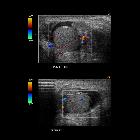ground-glass attenuation
 ähnliche Suchen
ähnliche Suchenground glass opacities
ground-glass attenuation
Ground glass opacification
GGOs
Ground-glass opacification/opacity (GGO)
Ground glass attenuating regions
Groundglass attenuation regions
Ground glass attenuation regions
Ground glass attenuation
Ground glass density
Ground glass opacities (GGO)
Differential of ground-glass opacity
Differential of ground glass opacities
ground-glass opacification
ground-glass changes
ground glass
ground glass opacity
ground-glass
differential diagnosis of ground glass opacification
Milchglastrübung
Milchglas
differential of ground-glass opacities
differential of ground glass opacity
ground glass densities
ground-glass opacity
ground glass opacites
ground glass changes
 siehe auch
siehe auchKryptogene organisierende Pneumonie (COP)
Honigwabenmuster
Granulomatose mit Polyangiitis
acute respiratory distress syndrome (ARDS)
pulmonale und mediastinale Sarcoidose
In Situ Adenokarzinom der Lunge
Milchglasherd
vaping-induced acute lung injury (EVALI)
non specific interstitial pneumonia (NSIP)
gewöhnliche interstitielle Pneumonie (UIP)
lymphozytisch interstitielle Pneumonie
Lungenkontusion
Pneumocystis jiroveci Pneumonie
aspergillosis
idiopathic hypereosinophilic syndrome
pulmonale Eosinophilie
Akute interstitielle Pneumonie
diffuse ground glass nodules
acute eosinophilic pneumonia (AEP)
respiratory bronchiolitis–associated interstitial lung disease
infective bronchiolitis
CT halo sign
Desquamative interstitielle Pneumonie (DIP)
Idiopathische interstitielle Pneumonie
IgA-Vaskulitis
Ground-glass opacification/opacity (GGO) is a descriptive term referring to an area of increased attenuation in the lung on computed tomography (CT) with preserved bronchial and vascular markings. It is a non-specific sign with a wide etiology including infection, chronic interstitial disease and acute alveolar disease.
Ground glass opacification is also used in chest radiography to refer to a region of hazy lung radiopacity, often fairly diffuse, in which the edges of the pulmonary vessels may be difficult to appreciate .
The use of the term ground glass derives from the industrial technique in glassmaking whereby the surface of normal glass is roughened by grinding it.
Pathology
Etiology
Ground-glass opacities have a broad etiology:
- normal expiration
- on expiratory acquisitions, which can be detected if the posterior membranous wall of the trachea is flattened or bowed inwards
- partial filling of air spaces
- partial collapse of alveoli
- interstitial thickening
- inflammation
- edema
- fibrosis
- lepidic proliferation of neoplasm
Morphological forms
- focal ground-glass opacification (i.e. ground-glass nodule)
- diffuse ground-glass opacification
- isolated diffuse ground-glass opacification
Differential diagnosis
Broadly speaking, the differential for ground-glass opacification can be split into :
- infectious processes (opportunistic vs non-opportunistic)
- chronic interstitial diseases
- acute alveolar diseases
- other causes
Infections
Opportunistic
- pneumocystis pneumonia (PCP/PJP)
- cytomegalovirus (CMV) pneumonia
- herpes simplex virus (HSV) pneumonia
- respiratory syncytial virus (RSV) bronchiolitis: type of infectious bronchiolitis
- other infectious causes
Non-opportunistic
Chronic interstitial diseases
- eosinophilic pneumonias: ground-glass opacification can be seen in many of the eosinophilic pneumonias but is most commonly seen in :
- simple pulmonary eosinophilia (SPE): nodules with a GGO halo
- idiopathic hypereosinophilic syndrome (IHS): nodules with a GGO halo
- acute eosinophilic pneumonia (AEP): bilateral patchy areas of GGO with interlobular septal thickening
- eosinophilic drug reactions: peripheral airspace consolidation and GGO
- idiopathic interstitial pneumonias
- non-specific interstitial pneumonia: GGO with linear or reticular markings, micronodules, consolidation, and microcystic honeycombing
- usual interstitial pneumonia (UIP): focal GGO with macrocystic honeycombing, reticular opacities, traction bronchiectasis, and architectural distortion
- cryptogenic organizing pneumonia (COP): formerly bronchiolitis obliterans with organizing pneumonia (BOOP); GGO with airspace consolidation and mild bronchial dilatation
- exudative phase of acute interstitial pneumonia (AIP): diffuse lung consolidation with GGO
- respiratory bronchiolitis-associated interstitial lung disease (RB-ILD): patchy GGO centrilobular nodules and bronchial wall thickening
- desquamative interstitial pneumonia (DIP): GGO with linear or reticular opacities
- lymphoid interstitial pneumonia (LIP): GGO often in association with perivascular cystic lesions, septal thickening, and centrilobular nodules
- sarcoidosis (pulmonary manifestations of sarcoidosis)
Acute alveolar disease
- alveolar edema or pulmonary edema
- hypersensitivity pneumonitis: especially acute and subacute forms
Other causes
- neoplastic processes with a lepidic proliferation pattern
- atypical adenomatous hyperplasia
- localized adenocarcinoma
- adenocarcinoma in situ or minimally invasive (formerly bronchoalveolar cell carcinoma)
- drug toxicity
Rare causes
- focal interstitial fibrosis: a non-neoplastic entity with a nodular ground-glass opacity that does not change over a long period of time; can be mistaken for a neoplastic process
- aspergillosis: a nodule with surrounding ground-glass opacity (CT halo sign) is rare except in severely immunocompromised patients
- thoracic endometriosis
- traumatic lung injury (pulmonary contusion)
- poisoning e.g. acute/subacute phase of paraquat poisoning
- pulmonary cryptococcus infection: solitary or multiple pulmonary nodules with or without peripheral GGO
- granulomatosis with polyangiitis
- Henoch-Schönlein purpura
- metal fume fever
See also
Siehe auch:
- Sarkoidose
- Kryptogene organisierende Pneumonie (COP)
- Honigwabenmuster
- Granulomatose mit Polyangiitis
- acute respiratory distress syndrome (ARDS)
- pulmonale und mediastinale Sarcoidose
- In Situ Adenokarzinom der Lunge
- Milchglasherd
- vaping-induced acute lung injury (EVALI)
- non specific interstitial pneumonia (NSIP)
- gewöhnliche interstitielle Pneumonie (UIP)
- lymphozytisch interstitielle Pneumonie
- Lungenkontusion
- Pneumocystis jiroveci Pneumonie
- aspergillosis
- idiopathic hypereosinophilic syndrome
- pulmonale Eosinophilie
- Akute interstitielle Pneumonie
- diffuse ground glass nodules
- acute eosinophilic pneumonia (AEP)
- respiratory bronchiolitis–associated interstitial lung disease
- infective bronchiolitis
- CT halo sign
- Desquamative interstitielle Pneumonie (DIP)
- Idiopathische interstitielle Pneumonie
- IgA-Vaskulitis
und weiter:
- mosaikartige Verdichtungen der Lunge
- umgekehrtes Halozeichen Lunge
- Hypersensitivitätspneumonitis
- angioinvasive pulmonale Aspergillose
- reverse halo sign
- Alveolarproteinose
- Sjögren-Syndrom
- pulmonary opacification
- lung torsion
- alveoläre Mikrolithiasis
- Strahlenpneumonitis
- infectious bronchiolitis
- bronchus associated lymphoid tissue lymphoma
- HRCT terminology
- acute eosinophilic pneumonia
- sub acute extrinsic allergic alveolitis
- eosinophile Granulomatose mit Polyangiitis
- byssinosis
- pulmonale Manifestationen der Leukämie
- head cheese sign
- Kaposisarkom
- diffuse idiopathische pulmonale neuroendocrine Zellhyperplasie
- diffuses Milchglasphänomen
- follikuläre Bronchiolitis
 Assoziationen und Differentialdiagnosen zu Milchglasverschattungen:
Assoziationen und Differentialdiagnosen zu Milchglasverschattungen:
















































